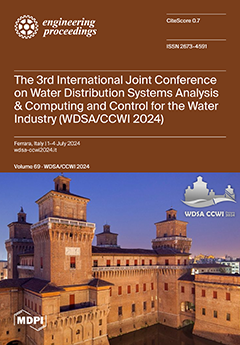Eng. Proc., 2024, WDSA/CCWI 2024
The 3rd International Joint Conference on Water Distribution Systems Analysis & Computing and Control for the Water Industry (WDSA/CCWI 2024)
Ferrara, Italy | 1–4 July 2024
Volume Editors:
Stefano Alvisi, University of Ferrara, Italy
Marco Franchini, University of Ferrara, Italy
Valentina Marsili, University of Ferrara, Italy
Filippo Mazzoni, University of Ferrara, Italy
- Issues are regarded as officially published after their release is announced to the table of contents alert mailing list.
- You may sign up for e-mail alerts to receive table of contents of newly released issues.
- PDF is the official format for papers published in both, html and pdf forms. To view the papers in pdf format, click on the "PDF Full-text" link, and use the free Adobe Reader to open them.




